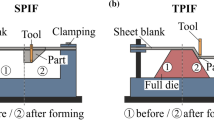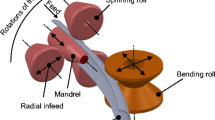Abstract
In forming technology, the principle of stress superposition is well known for a controlled influencing of the forming zone. The aim of stress superposition is to reach an additional plastification of the material, which can be used to compensate the springback effect, e.g. of bending angles or bending radii, to extend the forming limits of the material and to reduce the forming forces. The paper deals with two new forming process variants invented by the authors, which are based on the principle of stress superposition. The first is an air bending process using an additional roll for the incremental superposition of compressive stresses along the tensile zone of a bent sheet metal. The second is the new process of incremental tube forming, which is suitable for bending tubes two- and three-dimensionally to arbitrary contours. It is based on the combination of a spinning process with the free forming of tubes.














Similar content being viewed by others
References
Finckenstein Ev, Adelhof A, Kleiner M (1988) Erweiterung der Verfahrensgrenzen beim Hochkantbiegen im Walzrundverfahren. Blech Rohre Profile 35(10):783–787
Chatti S (2006) Production of profiles for lightweight structures. Habilitation thesis, Books on demand GmbH, ISBN 3-8334-4929-2
Sulaiman H (1995) Erweiterung der Einsetzbarkeit von Gesenkbiegepressen durch die Entwicklung von Sonderwerkzeugen. Dr.-Ing. dissertation, University of Dortmund
Müller-Duysing M (1993) Die Berechnung und adaptive Steuerung des Drei-Punkt-Biegens. Dr.-Ing. dissertation, Eidgenössische Technische Hochschule Zürich
Roll K, Lemke T, Wiegand K (2004) Simulationsgestützte Kompensation der Rückfederung. LS-DYNA User Forum, Bamberg
Kuhn D (2007) Neue Stahlwerkstoffe und Fertigungstechnik als Basis für den künftigen Automobilbau. Maschinenmarkt 35:26–30
Albrecht V (2008) Biegen ohne Grenzen. Industrieanzeiger 12:42–45
Hoffmann O (2005) Die Basis für modernen Leichtbau. Blech 1:24–27
Pahl G, Beitz W, Feldhusen J, Grote K-H et al (2007) Engineering design: a systematic approach, 3rd edn. Springer, Germany
Murata M, Kuboti T, Takahashi K (2007) Characteristics of tube bending by MOS bending machine. In: Proceedings of the 2nd international conference on new forming technology, 20–21/09/2007. Bremen, pp 135–144
Neugebauer R, Drossel W-G, Lorenz U, Luetz N (2002) Hexabend—a new concept for 3D-free-form bending of tubes and profiles to preform hydroforming parts and endform space-frame-components. In: Proceedings of the 7th ICTP, Yokohama, vol 2, 28–31/10/2002. Advanced Technology of Plasticity, pp 1465–1470
Author information
Authors and Affiliations
Corresponding author
Rights and permissions
About this article
Cite this article
Kleiner, M., Tekkaya, A.E., Chatti, S. et al. New incremental methods for springback compensation by stress superposition. Prod. Eng. Res. Devel. 3, 137–144 (2009). https://doi.org/10.1007/s11740-009-0151-7
Received:
Accepted:
Published:
Issue Date:
DOI: https://doi.org/10.1007/s11740-009-0151-7




